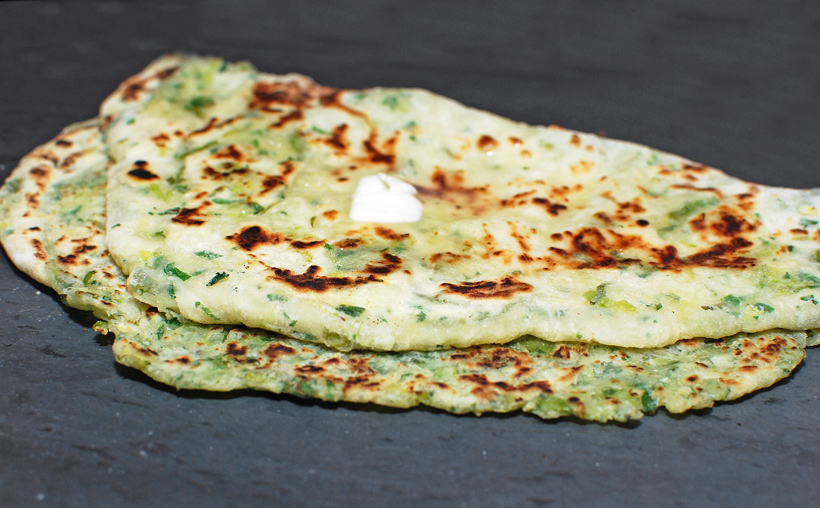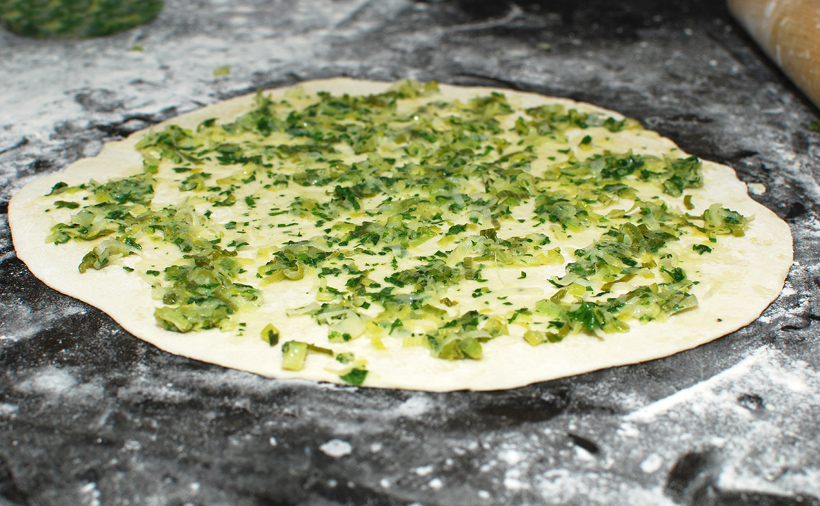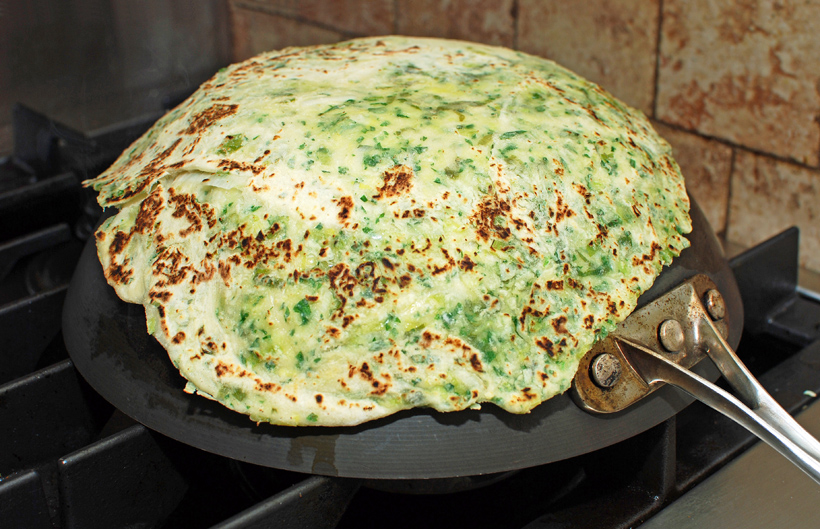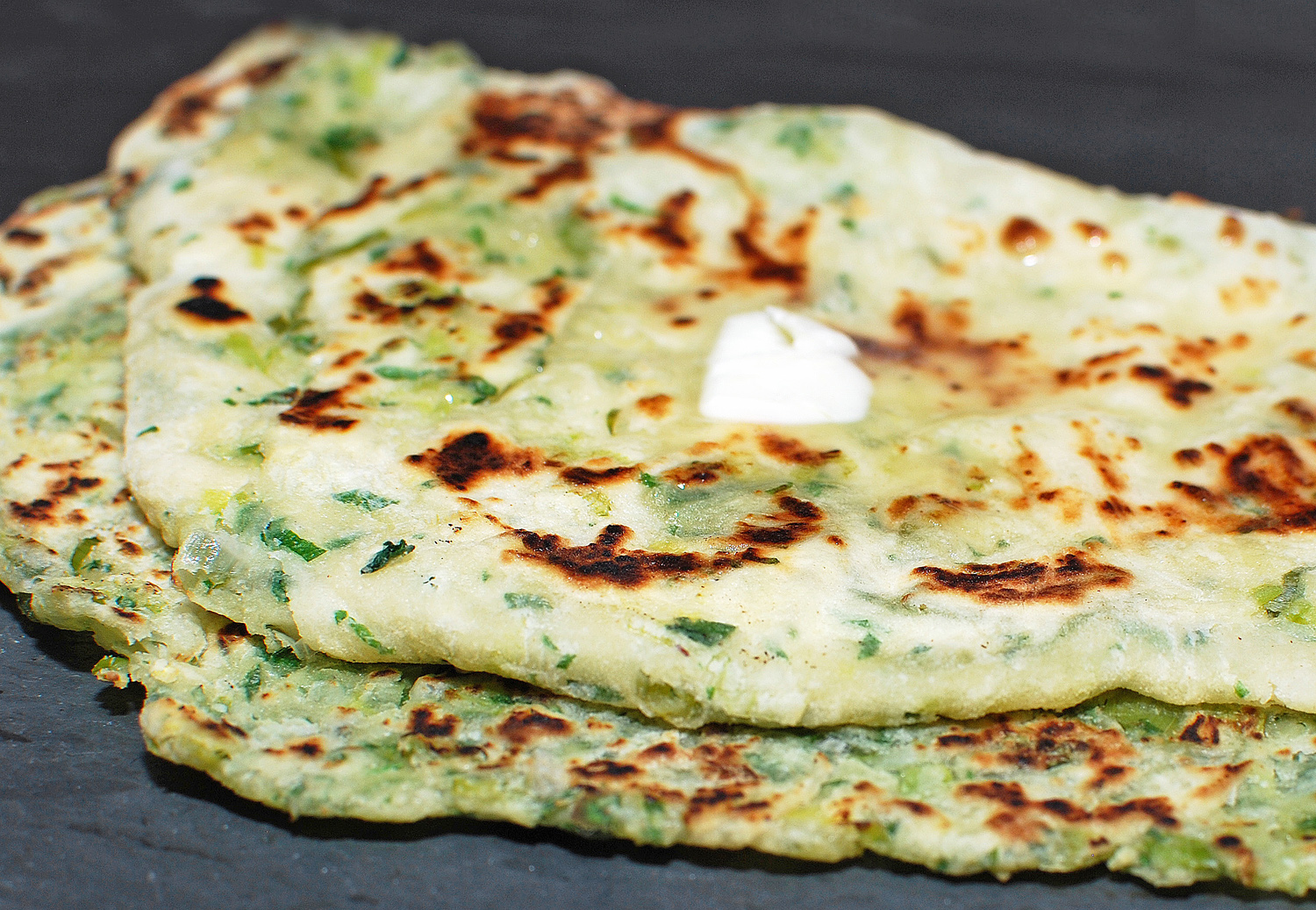Zhingalov khats, a flatbread with a variety of fresh herbs, is a specialty from Nagorno-Karabakh (literally, it means bread with herbs in Armenian). If you ever visit the market in Stepanakert, you can taste the real deal made fresh in front of you. Unfortunately, that might be your only chance to do so: at the time of writing, my Internet and cookbook searches didn’t return a single recipe for zhingalov khats! To further complicate the matter, the name of the dish is transliterated in different ways, such as zhengyalov hac or jingalov hats.
The flatbread is supposedly made with 7 fresh herbs (some other sources online said 8, 9, or 27), one or two of which are obligatory (which ones, we don’t know). The dough is rolled out, chopped herbs are placed on top, the sides are folded over and the whole thing is rolled out again before being cooked on a griddle. This link gathers most of the information one can find on zhingalov khats, including a rather funny video of a TV show broadcast on the Russian First TV channel. There are also some rare photographs from markets in Karabakh here, here, and here.

But finally, my dear Caucasian foodies, the wait is over. I am proud to offer you what I would modestly call the first ever written recipe for zhingalov khats, an undeniable cornerstone in the little-known culinary heritage of Nagorno-Karabakh! It may not contain 27 or even 7 herbs, but it’s pretty good all the same. In fact, the tighter flavor profile will even help one recognize what’s in it, which is a big plus in my opinion. It also doesn’t follow the absurd diet restrictions that go with fasting for lent, and this makes it even tastier. Butter makes everything tastier, and nobody should tell you when to eat it and when not to.
The dough is identical to a lavash dough, the main difference being that it needs to be cooked longer. You can enjoy your zhingalov khats as a hot snack with a little bit of butter, or serve them with kebabs.
And don’t miss this fabulous song dedicated to Zhingalov Khats:
Lavash dough
Yields 4 flatbreads
6 oz water, lukewarm
1 1/2 tsp honey
1/4 tsp active dry yeast
10 oz flour, sifted
1/2 tsp salt
- In a cup, mix the water with the honey and yeast, and let rest for 10 minutes.
- Transfer to the bowl of an electric mixer fit with the paddle attachment, add about 3/4 of the flour, and mix on low speed for 1 minute. Add the rest of the flour and the salt, switch to the dough hook attachment, and knead for 5 minutes. Cover the bowl with plastic wrap, then let rise in a warm place until doubled in volume, for about 3 hours.
- Punch down the dough and let rest for another 10 minutes.

Zhingalov khats
Yields 4 flatbreads
2 1/2 oz thinly sliced leeks
2 1/2 oz thinly sliced scallions (white and green parts)
2 oz butter
3/4 oz finely chopped flat-leaf parsley
lavash dough
olive oil
- In a small saucepan, cook the leeks and scallions in butter over medium heat until soft. Remove from the heat, let cool, then mix in the parsley.
- Divide the dough into 4 equal pieces, and roll into 10″ x 12″ ovals using a rolling pin. Don’t forget to flour your work surface generously as you go, giving quarter turns to your dough between each roll.
- Spread the leek, scallion and parsley mixture evenly over the breads, fold over the sides, and roll out again to the same size, adding flour as necessary.
- Turn a wok upside down on a gas burner, and heat on the highest setting for a few minutes. Rub the wok with a paper towel soaked with olive oil, and place a flatbread on the wok. Flip several times, about every minute, until cooked through and nicely browned.
- Remove from heat and eat immediately. If you have to wait, cover with a towel, and spray with a bit of water before reheating.



10 comments
There are two obligatory ingredients in zhengyalov hats. One is chervil, because of its very unique taste, it gives the flatbread the flavour one can’t describe. The second ingredient is chrchrok, water grass, it looks like water cress, but it is a little bit smoother and lighter in colour. we put it in the bread filling to give the flatbread certain juiciness. Parsley, as a matter of fact, is never used in the flatbread, cilantro is, spinach as well. Also works to buy a package or two of cooking greens from Trader joe’s, if you live in the US and have any around, add some onions, etc. and it will be as good. Olive oil has a peculiar smell, it will be better to use an oil without any smell, such as corn oil, or refined sunflower oil. Yeast has to be used minimally or not at all, since first of all, dough will not be able to roll thinly as paper and it may become so soft that it will tear and not hold greens inside. Secondly, we must remember, this flatbread is a spring food, just when Great Fast occurs, hence, culturally and historically it is vegan and no yeast should be added. Also, one DOES NOT and SHOULD NOT cook the ingredients in advance in butter or in anything for that matter. All is cooked inside of the dough and is preferred to stay green and crunchy. One needs to flip this flatbread only once, not several times, this way the dough will toughen and greens will overcook. Where did you eat the jengyalov hac you described?
Wow, a Zhingalov Khats expert! Thanks a lot for taking the time to provide some detailed feedback. This also gave me a chance to revisit this post and provide a little update. I should mention, however, that my goal is not to provide a traditional recipe as transmitted by Nagorno-Karabakh grandmothers from generation to generation, but to re-interpret existing dishes in my own way. This being said, I have a few comments about your advice:
– After detailing the dos and don’ts of herb mixing, you recommend getting “cooking greens from Trader Joe’s”. Come on, we can do better than that!
– I chose olive oil precisely because I like its taste.
– Yeast is vegan.
– I don’t fast for lent, so I DO and SHOULD use butter whenever I want.
– I guarantee you that I can flip the bread several times and keep the dough soft, or vice versa.
wow, this is awesome. i just learned about this via facebook blogs, just pictures, or actual videos, but no recipes. so this is great you posted information. this bread even has it’s own facebook page with another different video from armenia. it’s just a demo with no recipe though. i’m really surprised to learn it no parsley. other than all the prep work of the greens, it seems like a fairly simple process. i’m going to try and introduce this to our church’s festival. i think one hatz, with a piece of feta, makes a great item.
Wonderful feedback, exactly what I remember of it being made back home 🙂 I finally found chervil and will be growing it for jhingalov hats specifically.
Growing your own chervil, way to go! I don’t know why it’s so much harder to find than other herbs in the US.
Excellent blog. Have just been translating my Armenian aunt’s Zhengyalav Hatz recipe and decided to google it, stumbled across your wonderful blog. She uses spinach, sorrel, dill and parsley – in case you are curious.
I love your previous comment – ‘I DO and SHOULD use butter’. Brilliant. I’m with you on that one, and love it that you reinterpret dishes and are unapologetic about it. Bravo monsieur Florian. I am a fan.
Thanks, Olia! You have a nice blog too!
As I was told by the Queen of Zhingyalov Hats, Donara, this summer in Stepanakert market, absolutely NO petrushka (parsley)!
We made the flat breads together at the market.
She uses 17 herbs/greens and onion and simply unyeasted dough.
I have my own food blog and I think it’s important to specify when a recipe is your “own interpretation” and not the original.
Hi Sandra, as explained on my About page, my goal is to help re-invent the cuisines of the former eastern bloc. The very title of this blog suggests just that. My posts are often peppered with comments about all the good I think of tradition (the mother of ignorance) and obtuse people who’ve decided what one must and must not put in a given dish.